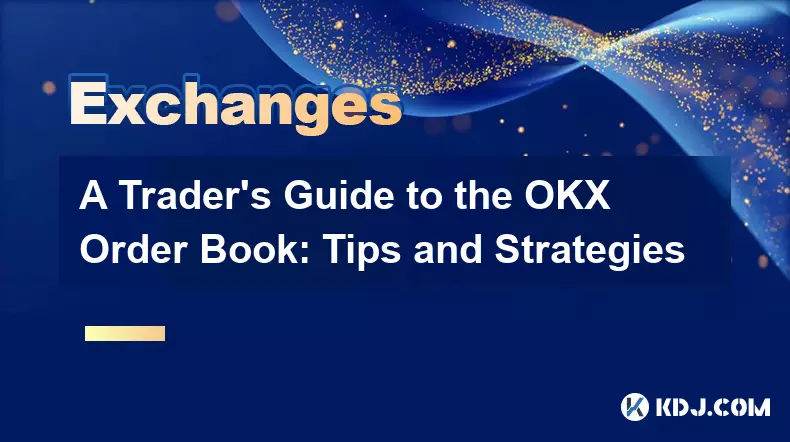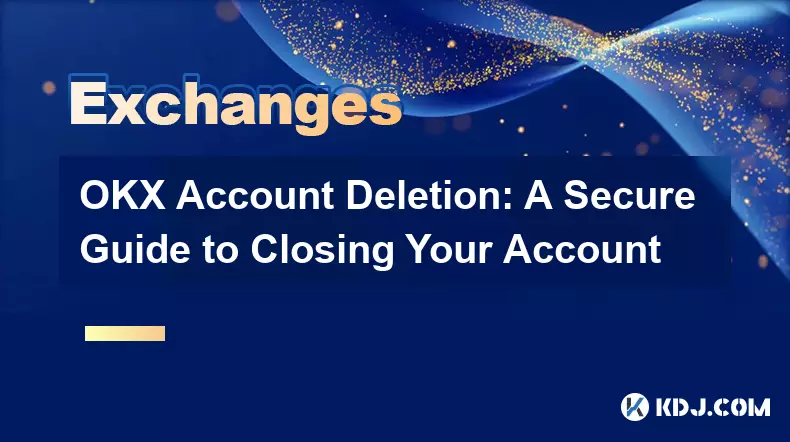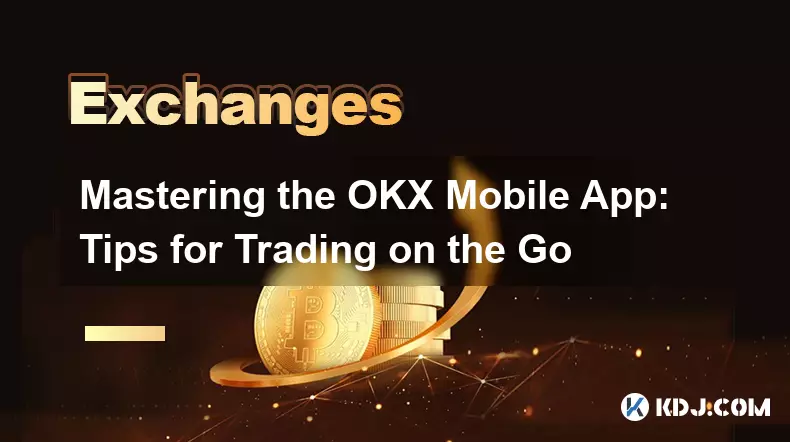-
 bitcoin
bitcoin $100977.009184 USD
-2.05% -
 ethereum
ethereum $3282.009150 USD
-3.23% -
 tether
tether $0.999813 USD
-0.02% -
 xrp
xrp $2.208254 USD
-4.89% -
 bnb
bnb $951.411089 USD
0.55% -
 solana
solana $155.761205 USD
-2.84% -
 usd-coin
usd-coin $1.000217 USD
0.02% -
 tron
tron $0.284475 USD
-1.28% -
 dogecoin
dogecoin $0.162363 USD
-1.53% -
 cardano
cardano $0.533988 USD
-0.47% -
 hyperliquid
hyperliquid $39.174339 USD
-3.22% -
 chainlink
chainlink $14.724828 USD
-1.16% -
 bitcoin-cash
bitcoin-cash $477.297986 USD
-1.28% -
 zcash
zcash $554.227426 USD
17.30% -
 ethena-usde
ethena-usde $0.998995 USD
-0.03%
A Trader’s Guide to the OKX Order Book: Tips and Strategies
The OKX order book reveals real-time market depth, with bid-ask spreads, price-time priority execution, and order flow patterns helping traders gauge liquidity, sentiment, and potential price movement.
Nov 05, 2025 at 03:45 pm

Understanding the OKX Order Book Structure
1. The OKX order book displays real-time buy and sell orders for a given trading pair, arranged by price level. On the left side, bids represent traders willing to purchase at specific prices, while asks on the right show those looking to sell. Each price level includes the volume available, allowing users to assess market depth.
2. Price clustering often occurs around key support and resistance zones. Traders can identify these clusters by observing where large volumes of orders accumulate. These areas may act as magnets or barriers during price movements, influencing short-term direction.
3. The spread between the highest bid and lowest ask reflects liquidity and market efficiency. A tight spread usually indicates strong participation and healthy trading activity, particularly in major pairs like BTC/USDT. Wider spreads may suggest lower liquidity or increased volatility.
4. Orders are executed based on price-time priority. This means that higher bids and lower asks get precedence, and among equal prices, earlier entries are filled first. Understanding this mechanism helps traders time their entries more effectively.
5. Hidden orders and iceberg detection aren't visible directly but can be inferred through sudden absorption of large market orders. When substantial volume disappears without moving the price significantly, it often signals the presence of large players using discretion.
Reading Market Sentiment from Order Flow
1. A dense wall of buy orders at a specific price can indicate strong demand, potentially serving as a floor. Conversely, a thick stack of sell orders might signal resistance. These walls don’t always hold, especially under high momentum, but they provide valuable context for potential turning points.
2. Rapid depletion of bids or asks suggests aggressive market participation. If buyers consistently lift offers, pushing price upward while reducing available asks, it reflects bullish pressure. The opposite occurs when sellers overwhelm the bid side.
3. Sudden disappearance of large limit orders without execution may hint at manipulation or spoofing. Some traders place sizable orders to create false impressions of supply or demand, then cancel them before execution. Monitoring order book dynamics closely helps detect such behavior.
4. Asymmetry in order book depth can reveal imbalance. For example, if the buy side shows significantly more volume than the sell side, it may precede an upward move—assuming no immediate overhang from resting sell orders above.
5. Time-lapse observation of the order book across different intervals allows traders to spot recurring patterns. Certain price levels reappear as magnets during consolidation phases, offering repeatable reference points for entries and exits.
Strategies for Leveraging Order Book Data
1. Placing limit orders just behind large walls can increase fill probability while avoiding slippage. For instance, setting a buy order slightly below a prominent bid cluster allows entry near support without competing with the front-runners.
2. Using stop-limit orders in conjunction with observed resistance zones helps manage risk. By identifying where sell walls form, traders can position stops just below key levels to minimize losses if breakout attempts fail.
3. Scalping strategies benefit greatly from real-time order book updates. Traders targeting small gains per trade rely on micro-movements driven by shifts in bid-ask balance. Fast reaction to order flow changes provides an edge in high-frequency scenarios.
4. Fading breakouts is another tactic rooted in order book analysis. When price approaches a known cluster of resting sell orders and fails to clear them, initiating a short position with a target at the next support level becomes viable. Confirmation comes from shrinking bid depth and increasing sell-side aggression.
5. Pairing order book insights with volume profile tools enhances accuracy. High-volume nodes aligned with order book imbalances offer stronger confirmation for potential reversals or continuations.
Frequently Asked Questions
How do I distinguish between genuine support and artificial order walls?Genuine support typically persists over time and aligns with historical price reactions. Artificial walls appear suddenly, lack follow-through volume, and vanish quickly. Cross-referencing with time-and-sales data helps verify legitimacy.
Can the OKX order book be used for altcoin trading?Yes, though altcoins often exhibit thinner order books and wider spreads. This increases sensitivity to individual trades, making it essential to account for higher volatility and potential manipulation risks.
Is it advisable to trade solely based on order book data?Relying exclusively on the order book carries risk due to latency, spoofing, and incomplete information. It should complement other tools like candlestick patterns, volume indicators, and on-chain metrics for balanced decision-making.
What tools enhance order book analysis on OKX?Traders use depth chart overlays, Level 2 data feeds, and third-party platforms that visualize order book heatmaps. Browser extensions and API integrations also allow for customized alerts and automated monitoring of critical levels.
Disclaimer:info@kdj.com
The information provided is not trading advice. kdj.com does not assume any responsibility for any investments made based on the information provided in this article. Cryptocurrencies are highly volatile and it is highly recommended that you invest with caution after thorough research!
If you believe that the content used on this website infringes your copyright, please contact us immediately (info@kdj.com) and we will delete it promptly.
- BlockDAG, Avalanche, Dogecoin: Crypto's Leading Trio in 2025
- 2025-11-07 22:05:01
- Layer 2 Coins: Will There Be a Potential Explosion by 2026?
- 2025-11-07 16:50:02
- Filecoin, ICP, and the AI Infrastructure Renaissance: Is History Repeating?
- 2025-11-07 16:50:02
- Bitcoin's Wild Ride: Surges, Zeros, and the Search for Stability
- 2025-11-07 17:05:01
- XRP, Bitcoin, and the Rally: What's the Deal, New York?
- 2025-11-07 17:25:01
- Filecoin, DePIN, and a Technical Breakout: What's the Buzz?
- 2025-11-07 17:05:01
Related knowledge

Common Mistakes to Avoid on OKX: A Guide for New Traders
Nov 04,2025 at 03:37pm
Understanding the Interface Before Trading1. New traders often jump into placing orders without fully exploring the OKX platform layout. Taking time t...

OKX TradingView Integration: A Guide to Advanced Chart Analysis
Nov 02,2025 at 03:37am
OKX and TradingView: Bridging the Gap for Professional Traders1. OKX, one of the leading cryptocurrency exchanges, has integrated with TradingView to ...

Finding Your OKX Deposit Address: A Quick and Safe Guide
Nov 05,2025 at 01:15pm
Finding Your OKX Deposit Address: A Step-by-Step Process1. Log into your OKX account using your registered credentials. Ensure you are accessing the o...

OKX Savings Guide: A Low-Risk Strategy for Earning Crypto
Nov 05,2025 at 06:55am
Understanding OKX Savings and Its Role in Crypto Earnings1. OKX Savings offers users a straightforward method to earn passive income by leveraging idl...

OKX Account Deletion: A Secure Guide to Closing Your Account
Nov 05,2025 at 08:44am
Understanding the Implications of Account Closure1. Closing your OKX account permanently removes access to all associated trading features, including ...

Mastering the OKX Mobile App: Tips for Trading on the Go
Nov 05,2025 at 01:19am
Streamlined Navigation for Efficient Trading1. The OKX mobile app features a clean and intuitive interface that allows traders to access key functions...

Common Mistakes to Avoid on OKX: A Guide for New Traders
Nov 04,2025 at 03:37pm
Understanding the Interface Before Trading1. New traders often jump into placing orders without fully exploring the OKX platform layout. Taking time t...

OKX TradingView Integration: A Guide to Advanced Chart Analysis
Nov 02,2025 at 03:37am
OKX and TradingView: Bridging the Gap for Professional Traders1. OKX, one of the leading cryptocurrency exchanges, has integrated with TradingView to ...

Finding Your OKX Deposit Address: A Quick and Safe Guide
Nov 05,2025 at 01:15pm
Finding Your OKX Deposit Address: A Step-by-Step Process1. Log into your OKX account using your registered credentials. Ensure you are accessing the o...

OKX Savings Guide: A Low-Risk Strategy for Earning Crypto
Nov 05,2025 at 06:55am
Understanding OKX Savings and Its Role in Crypto Earnings1. OKX Savings offers users a straightforward method to earn passive income by leveraging idl...

OKX Account Deletion: A Secure Guide to Closing Your Account
Nov 05,2025 at 08:44am
Understanding the Implications of Account Closure1. Closing your OKX account permanently removes access to all associated trading features, including ...

Mastering the OKX Mobile App: Tips for Trading on the Go
Nov 05,2025 at 01:19am
Streamlined Navigation for Efficient Trading1. The OKX mobile app features a clean and intuitive interface that allows traders to access key functions...
See all articles





















![The Graph Price Prediction [GRT Crypto Price News Today] The Graph Price Prediction [GRT Crypto Price News Today]](/uploads/2025/11/07/cryptocurrencies-news/videos/690d4df44fe69_image_500_375.webp)




















































